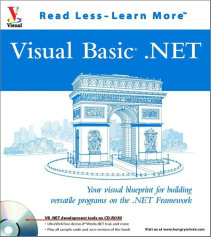|

VB.Net
By Richard Bowman
Reviewed by Fred Thorlin
In spite of what I have said in the past, I am getting into VB.Net. I have attacked several of the
better-known books on the topic with the zeal of a convert. Unfortunately, they have counter-attacked
with such tendentious erudition that I have never made it past page fifty.
But wait. Relief has appeared in the form of a book with the catchy and distinctive title of
VB.Net.
The publishers may have decided that it would stand out by having square pages, but this is hard to
detect when looking at book spines. The only thing that stands out is the taste and presentation.
Taste, in that it doesn't try to definitively cover every nuance of the language, only the highlights.
Presentation, in that the information is carefully ordered, clearly presented in easily comprehended two-page frames.
STOP format documentation was first developed in the 1960s as an advance in the way information is presented.
STOP stands for Single Topic On a Page. With STOP format each page covers only one topic.
If the topic is too big, it is broken down into smaller topics. A famous example is
Bobby Fischer Teaches Chess.
(The book to read to learn chess in an afternoon from the master. His only book I believe.
Sample pages are available at amazon.com.)
VB.Net.
uses a slightly different format. Each frame covers two facing pages. The topic is covered
in the top of the left hand page. Across the bottom of the facing pages are screen shots walking
the reader through an example. The top of the right page usually has an "Extra" section that
discusses an advanced aspect of the topic; usually with an expanded program.
The topics are very well selected. The book covers the bread and butter material like text entry
and adding forms, but this is spiced with the dazzling new stuff like control resizing,
print preview and web forms. The book purports to be for anyone with Windows and programming familiarity.
I am willing to believe that it is better than anything else available for this population, but to deny its being directed to users of earlier versions of VB is to challenge reason. One handy frame is entitled "Language Changes from Visual Basic 6.0". QED
The effort to serve all constituencies results in some absurd practices throughout. Frame after frame
the step instructions advise the reader that "replacing X with the variable name" when X, or whatever
appears in the example, is a perfectly good variable name. After the tenth time you see this you
recognize it as the work of some non-programming editor placing his imprimatur on the book. I quickly
came to look at the editorial foibles as the charming quirks of a close friend. I do hope they
will be removed in a second edition though. Say what they like, this is a book for users of earlier
versions of VB, not beginners. The book's energy level makes learning VB.Net with it fun.
A CD accompanies the book. It includes:
- An acrobat version of the book. For searching?
- Source files for each of the examples at the bottom of the pages. The programs are all so short
you must be truly lazy to use this feature. I often do.
- Sample beta versions of some interesting third party controls. There is so much stuff in the
.Net library that I expect life to be tough for these vendors.
Some segments of the book are amazing. You discover that you have been doing religiously correct OOP,
object oriented programming, before the topic is introduced. Do the example for "Download from a Web
Server" and it reads from a website the author provides! Do the Extra sections and you will find
yourself wandering off on your own exploring remoter regions of the language. VB.Net's Intellisense
advises you as to all of the options available as you type. The list of options can be huge and the
temptation of selecting an option, other than the one discussed in the text, is irresistible.
Fortunately the VB.Net Dynamic Help system is at hand to provide information on any syntax path
you may end up on. There are thousands of these.
The book got me so enthusiastic that I could not resist going off and writing a modest sized application
in VB.Net before finishing it. I found myself going back to the book to review things like string
functions. It was helpful, but it does not suffice as a reference. Dynamic Help is frequently good,
but it is clear there is a place for another reference.
I bought my copy of the book at Barnes & Noble. When you go shopping for the book, the photograph
of the cover accompanying this article will confirm to you that you have the correct book.
The ISBN is 0-7645-3649-4. The author is Richard Bowman. This is enough information to locate
it on the Internet where prices vary
[Amazon.com]
[Amazon.co.uk]
.
On the subject of prices, it is easy to get the impression
from Microsoft personnel, or even be told explicitly by them, that the only way to get
Visual Basic.Net is with some version of Visual Studio.Net, all costing over $500.
Not so! At
Programmer's Paradise
Visual Basic.Net is offered for under $100! However, I challenge you to find this product page on your own.
Suffice it to say that I feel there is a lot of great new stuff in VB.Net and am very enthusiastic
about this book as a way of starting learning it. It is easily digestible and fast paced yet, unlike
the Dummies books, you feel you have had a meal when you finish.
Fred Thorlin is a contract software developer with experience in compiler development now working with
Visual Basic and Palm computer environments. He also writes columns on Visual Basic programming and
computing on the road. He can be contacted at fredt@hal-pc.org.
| 